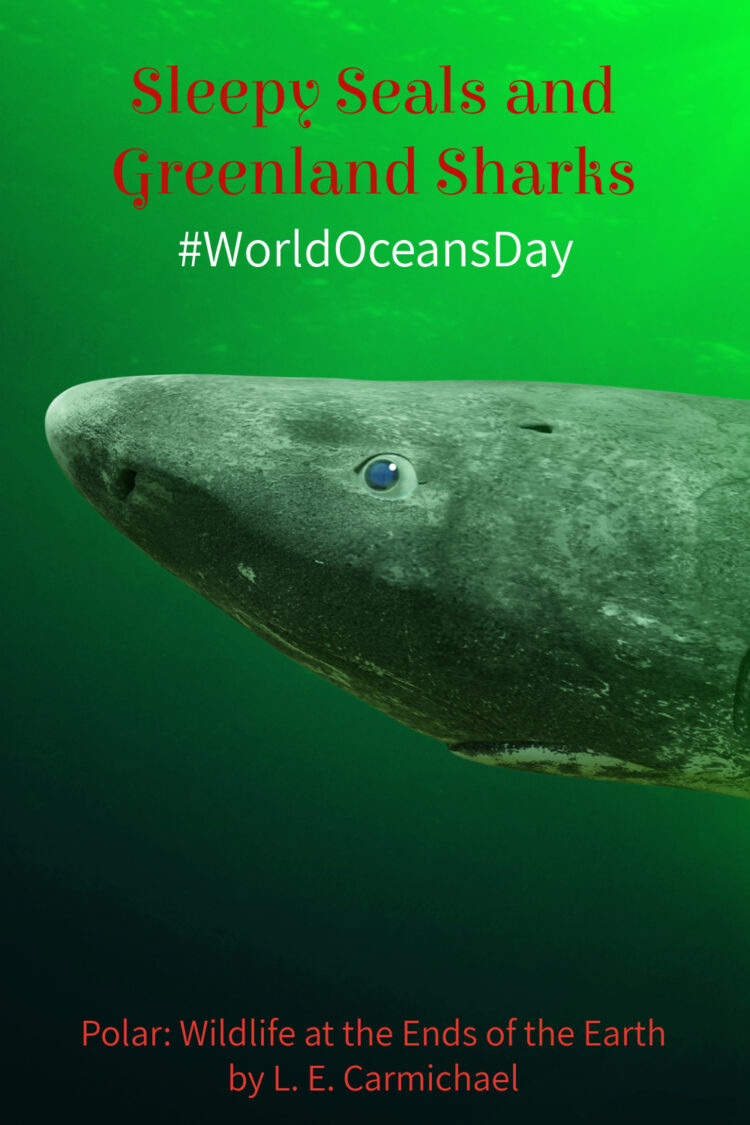I am so glad that World Oceans Day is finally here! I’ve been holding on to some truly AMAZING ocean info – info we cut from Polar: Wildlife at the Ends of the Earth due to concerns it was a little too intense for the average eight-year-old.
Intense and shudder-inducing and exactly the kind of thing my eight-year-old self was all over.
Content warning has been delivered: let’s dive in!
Sleepy Seals
Did you know that cetaceans and eared seals (fur seals and sea lions) have a thing called unihemispheric sleep? It means that only one side of their brains is asleep at a time, which is especially handy for whales and dolphins that can’t haul out of the water when they need a nap.
On the other hand, all of the other seals have bilaterally symmetrical sleep, just like land-based mammals. Both sides of their brain are sleeping at the same time, meaning they can’t detect or evade predators unless they wake up. Ringed seals protect themselves from stalking polar bears by sleeping in the water. But sleeping in the water makes them uniquely vulnerable to a predator of a different sort.
Dun dun… dunn dun… duuunnnn dun dun dun dun dun dun dun….
That’s right: sharks. Greenland sharks, to be precise.
For a long time, scientists thought Greenland sharks were scavengers. And they definitely feed on dead things – their stomach contents often include sea stars and other ocean-bottom species, in addition to meat from rotting carcasses (including at least one polar bear). More recent studies, however, have revealed shark stomachs that only contain fresh seal… meaning the sharks hunt live prey, too.

This is an illustration, not a photograph of a real shark. You can tell, because the creepy eye parasites are not pictured!
But seals are quick and nimble, whereas Greenland sharks often swim slower than the stall speed of scientific sensors – 0.17 m/s (compared to 0.85 m/s for great whites and 1.07 m/s for tiger sharks). So how can these slow-moving sharks catch live seals?
Camouflage and stealth. Greenland sharks have cryptic colouration that helps them blend into their ocean habitat, especially in the low light levels that are typical of Arctic winters or areas beneath the ice pack. It’s likely that seals don’t see the shark coming until it’s nice and close. It’s also likely that the sharks sneak up beneath sleeping prey and – rather than biting – suck whole seals into their gaping jaws.
Which leads to the question – if the water is full of hungry sharks, how can sleeping there be adaptive for the seals? Scientists figure seals are playing the odds… and that getting chomped by a polar bear is much more likely than getting swallowed by a shark.
Want more amazing Greenland shark facts? I’ve got ’em:
- Most Greenland sharks are infected by a parasite called Ommatokoita elongata. It bites onto the sharks’ eyeballs, its body dangling in the surrounding water, and can grow up to 6 cm long. There are pictures online, but you do not want to see them. Trust me: it’s nightmare fodder.
- The parasites impair the shark’s vision and may even cause blindness… but the shark just keeps swimming.
- Brain regions for eyesight in this shark are small, but about 1/3 of the brain is devoted to its sense of smell. Scientists suspect sharks are following “odour trails” through the sea. Seals are especially stinky, which would help sharks find them in the first place.
- The earliest fisheries record of the Greenland shark is from Norway, in the 13th century! In Iceland, people still eat them, but only after letting them… well, rot.
- The smallest Greenland shark ever caught was 42 cm long, suggesting they’re between 40 and 100 cm long at birth.
- Females must be at least 400 cm long to reproduce. Scientists estimate a shark that length is at least 156 years old!
- The largest Greenland shark ever caught was 640 cm long and weighed 1023 kg. It needed at least 272 years to get that big.
Because Greenland sharks spend most of their time in deep water, scientists don’t know very much about them. But animals that grow slowly and rarely reproduce are inherently vulnerable to habitat changes or overfishing. Check out the St. Lawrence Shark Observatory – originally the Greenland Shark & Elasmobranch Education and Research Group – to learn more about Canadian studies of this and other ocean species.
This World Oceans Day, gift your junior nature-lover a great science book. I recommend The Global Ocean, by Canadian author Rochelle Strauss!
Oh yeah, thanks for the heads-up about scary nature facts!
Glad to have read it, though.
Glad you enjoyed! The parasite thing is seriously shudder-inducing – do NOT google the images.